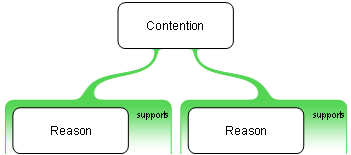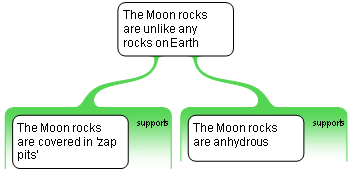
 |
|
|
|
|
| 3.1 Multi-Reason Arguments | |
Sometimes there is more than one reason for a particular contention. Such situations are called multi-reason arguments.

| Discussion |
Example:
The Moon rocks are unlike any rocks on Earth. To start, the Moon rocks are covered in 'zap pits'. Also, the Moon rocks are anhydrous. [based on 9.2-3]
This piece of reasoning contains two separate reasons for the same contention. That is, there are two separate simple arguments, but they have the same contention.
|
|
|
| The two simple arguments mapped on one argument "tree". |
 |
The core idea behind multi-reason arguments is that there is a single claim (the contention) with at least two quite distinct pieces of evidence bearing upon it.
In mapping multi-reason
arguments, there is no need to represent the contention twice; it is simpler to
have the two reasons pointing at the same claim box.
Complex argument structures, of which the above is the most elementary kind, are called argument trees because they have a root (the main contention) and branches. Note that logicians tend to draw their trees upside down.
Technical note: There is also a more technical definition of tree, in graph theory and computer science, and complex argument structures meet that definition also, but only at high level or coarse grain; when you introduce co-premises, the strict definition no longer applies.
| New Concepts |
A multi-reason argument is an argument with more than one reason or objection for a single contention.
| Glossary | Contents | |
|
Copyright © Critical Thinking Skills BV - |
|